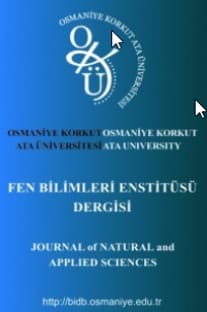Yeni Doğan Buzağıların Beslenmesinde Ağız Sütünün Önemi
The Importance of Colostrum in Nutrition of New Born Calves
___
- [1] Ünlü HB., Erkek R., Mert S., Özdoğan M. Buzağı beslemede doğal yem katkı maddelerinin kullanımı, Hayvansal Üretim 2013; 54(2): 36-42.
- [2] Heinrichs AJ., Jones C. Feeding the new born dair calf, The Pennsylvania State University 2003; 328 Boucke Building, University Park. USA: Cat.
- [3] Wattiaux AM., Howard TW. Dairy essentials, Babcock Institute for International Dairy Research and Development 1997; USA: WI 53706.
- [4] Kahrs RF. Infectious bovine rhinotracheitis: A review and update, J. Am. Vet. Med. Ass 1977; 171, 1055-1064.
- [5] Straub OC. Infectious bovine Rhinotracheitis virus. In virus ınfections of vertebrates, Series Ed. M.C. Horzinek, Vol.3: Virus Infections of Ruminants Ed. Z. Dinter, B. Morein, Elsevier Science Publishers BV,Amsterdam-Oxford-New York-Tokyo 1990; 71-108.
- [6] Kirk JH. Colostrum: The key to control of calfhood diseases and death loss, 2003. http://www.vetmed.ucdavis.edu/vetext/INF-DACOLOSTRUM.HTML
- [7] Walsh RB., Walton JS., Kelton DF., LeBlanc SJ., Leslie KE., Duffield TF. The effect of subclinical ketosis in early lactation on reproductive performance of postpartum dairy cows, J Dairy Sci 2007; 90, 2788-2796.
- [8] Karslı MA., Evci Ş. Buzağı kayıplarının önlenmesinde inek ve buzağı beslemesinin önemi, Lalahan Hay. Araşt. Enst. Dergisi 2018; 58 (Özel Sayı): 23-34.
- [9] Vicente F., Rodríguez ML., MartínezFernández A., Soldado A., Argamentería A., Peláez M., Roza-Delgado B. Subclinical ketosis on dairy cows in transition period in farms with contrasting butyric acid contents in silages, The Scientific World Journal Article 2014; ID 279614.
- [10] Tümer S. Buzağıların Bakım Ve Beslenmesi Ege Tarımsal Araştırma Enstitüsü Müdürlüğü Çiftçi Broşürü No: 87 1998, Menemen-İzmir.
- [11] Banerjee GC. A Text book of animal husbandry, 8th. New Delhi: Oxford and IBH Publishing Co. Pvt. Ltd; 2005.
- [12] Jasper J., Weary DM. Effects of ad libitum milk intake on dairy calves, Journal of Dairy Science 2002; 85(11): 3054-3058.
- [13] Erdem H., Atasever S. Yeni doğan buzağılarda kolostrumun önemi, OMÜ Zir. Fak. Dergisi 2005; 20(2): 79-84.
- [14] Blätter U., Hammon HM., Morel C., Philipona C., Rauprich A., Rome V., Le HuërouLuron Le I., Guilloteau P., Blum JW. Feeding colostrum, its composition and feeden duration variably modify proliferation and morphology of the intestine and digestive enzyme activities of neonatal calves, Journal of Nutrition 2001; 131, 1256-1263.
- [15] Tarım ve Orman Bakanlığı. Büyükbaş Hayvancılık (Sığırcılık) https://www.tarimorman.gov.tr/HAYGEM/Belgel er/Hayvanc%C4%B1l%C4%B1k/B%C3%BCy% C3%BCkba%C5%9F%20Hayvanc%C4%B1l%C 4%B1k/2017%20Y%C4%B1l%C4%B1/B%C3% BCy%C3%BCkba%C5%9F%20Hayvan%20Yeti %C5%9Ftiricili%C4%9Fi.pdf.
- [16] Devery-Pocius JE., Larson BL. Age and previous lactations as factors in the amount of bovine colostral immunoglobulins, J. Dairy Sci 1983; 66, 221.
- [17] Koyuncu M., Karaca M. Buzağılarda yaşama gücünün anahtarı “Kolostrum”, J. Anim. Prod 2018; 59(1): 67-78.
- [18] Hayvancılık/Büyükbaş Hayvancılık/2016 Yılı/Buzağı Bakım ve Beslenmesi.pdfwww.tarimorman.gov.tr
- [19] Selk GE. Disease protection for baby calves, 2003; http://osuextra.okstate.edu/pdfs/F3358web.pdf.
- [20] Sellers RA. Guide to colostrum and colostrum management for dairy calves, 2001; http://www.aphis.usda. gov /vs/ceah/ncahs/nahms/dairy/bamn/BAMN Colostrum.pdf
- [21] Valenta J., Zilkova JA. Practical method of grading, preservation and use of colostrum for calves in the first day of life, Veterinarstvi 1988; 38(6): 276-279.
- [22] Brinton AH., Whitlow LW. Feeding dairy heifers from birth to weaning, 2005;http://www.cals.ncsu.edu/an_sci/ extension /dairy/202D.pdf
- [23] Grusenmeyer DJ., Ryan CM., Galton DM., Overton TR. Shortening the dry period from 60 to 40 days does not affect colostrum quality but decreases colostrum yield by Holstein cows, Journal of Animal Science 2006; 84 (Suppl, 1): 336.
- [24] Mandebvu P., Ballard CS., Sniffen CJ., Tsang DS., Valdez F., Miyoshi S., Schlatter L. Effect of feeding an energy supplement prepartum and postpartum on milk yield and composition, and incidence of ketosis in dairy cows, Animal Feed Science and Technology 2003; 105, 81-93.
- [25] Stokol T., Nydam DV. Effect of hemolysis on nonesterified fatty acid and betahydroxybutyrate concentrations in bovine blood, J Vet Diagn Invest 2006; 18(5): 466-469.
- [26] Gillund P., Reksen O., Gröhn YT., Karlberg K. Body condition related to ketosis and reproductive performance in Norwegian dairy cows, J Dairy Sci 2001; 84, 1390-1396.
- [27] Heinrichs J. Measuring colostrum quality, Dairy Digest, April 2000; http://ww.das.psu.edu/XDairy.cfm
- [28] Shearer J., Mohammed HO., Brenneman JS., Tran TQ. Factors associated with concentrations of ımmunoglobulins in colostrum at the first milking post-calving, Pre.Vet. Med. 1992; 14(1-2): 143-154.
- [29] Morin DE., Constable PD., Maunsell FP. McCoy GC. Factors associated with colostral specific gravity in dairy cows, J. Dairy Sci. 2001; 84(4): 937-943.
- [30] Moran J. Calf rearing: A practical guide. Second edition. Collingwood, Vic, 3066, Australia: Landlinks Press, 150 Oxford Street (PO Box 1139); 2005.
- [31] Indra E., Daina K., Jeļena Z. Analysis of factors influencing immunoglobulin concentration in colostrum of dairy cows, Lucrări Ştiinţifice - Seria Zootehnie 2012; 57, 256-259.
- [32] Hoyraz M., Sezer R., Demirtaş M., Koç A. Siyah-alaca ineklerin ağız sütü kalitesi ve içeriği üzerine bir araştırma, Tralleis Elektronik Dergisi 2015; 4, 1-7.
- [33] Murphy BM., Drennan MJ., O’Mara FP., Earley B. Cow serum and colostrum immunoglobulin (IgG1) concentration of five suckler cow breed types and subsequent immune status of their calves, Irish Journal of Agricultural and Food Research 2005; 44, 205-213.
- [34] Göncü S., Mevliyaoğulları E., Koluman N. Siyah Alaca inek ve düvelerde kolostrum kalitesi ve buzağıların bağışıklık düzeyleri, Ç.Ü.Z.F. Dergisi 2013; 28(1): 31-38.
- ISSN: 2687-3729
- Yayın Aralığı: 5
- Başlangıç: 2017
- Yayıncı: Osmaniye Korkut Ata Üniversitesi
Hatay İlinde Üretilen Bazı Kuru Kaba Yemlerin Besin Madde İçeriklerinin Belirlenmesi
Süleyman ZAHAL, Şerafettin KAYA
Keban Baraj Gölü Seviye Değişiminin ANFİS ve Destek Vektör Makineleri ile Tahmini
Hatice ARSLAN, Fatih ÜNEŞ, Mustafa DEMİRCİ, Bestami TAŞAR, Ada YILMAZ
Biyodizel Yan Ürünlerinin Hayvan Beslemede Kullanımı
Diyarbakır İli Koyunculuğun Mevcut Durumu
Immunomodulatory Effects of Moringa Oleifera Leaf Meal (MOLM) against Newcastle Disease in Broilers
Madeeha AKRAM, Ijaz SALEEM, Muhammad FARHAB, Zubair LUQMAN
Gültekin ÖZDEMİR, B. Devrim ÖZCAN
M. Atakan AKAR, Oğuz BAŞ, Hasan SERİN, Berkay KARAÇOR, Mustafa ÖZCANLI
Balda Hile Tespitinde İzotopik Analiz Uygulamaları
